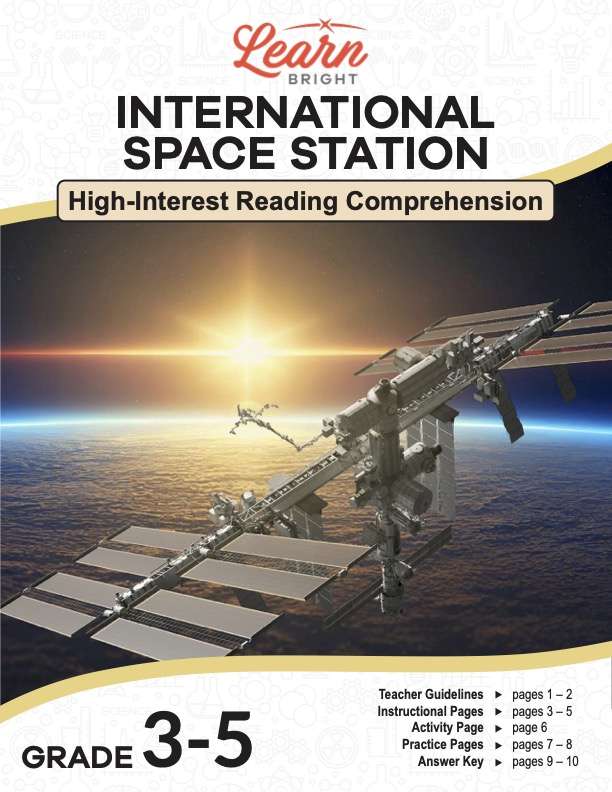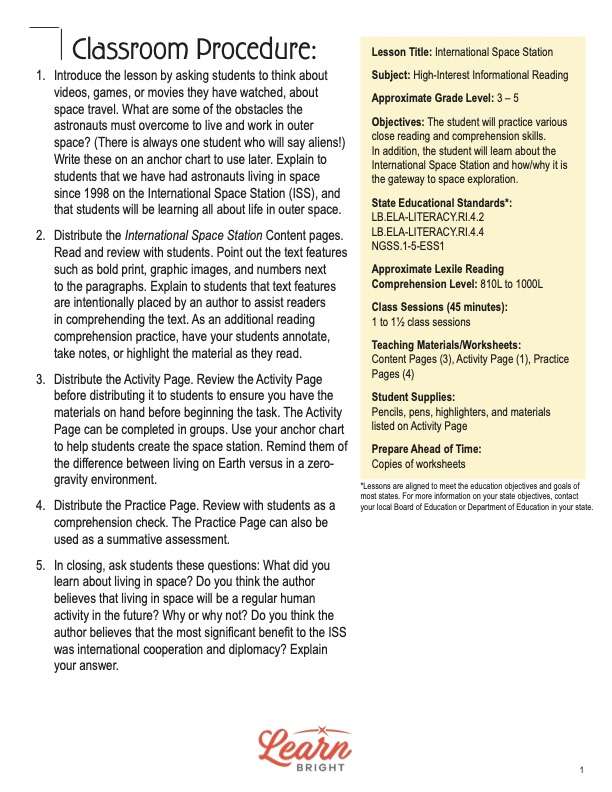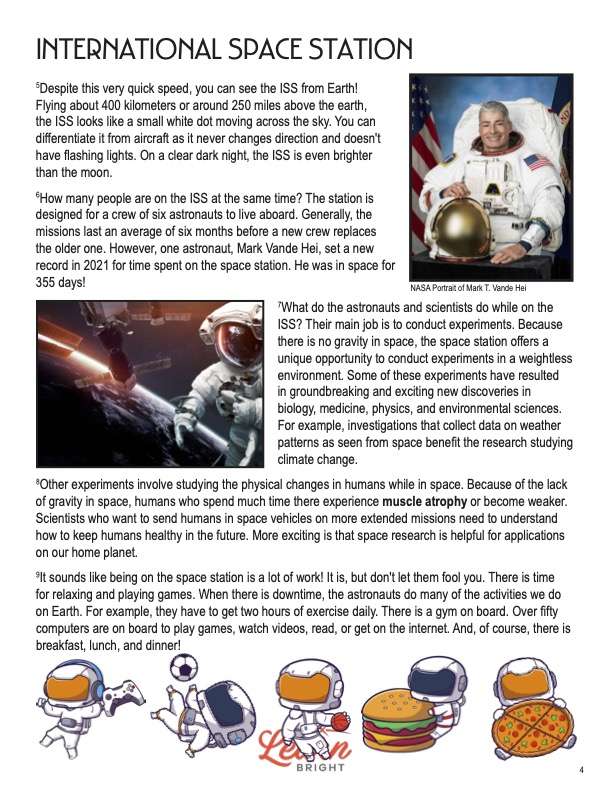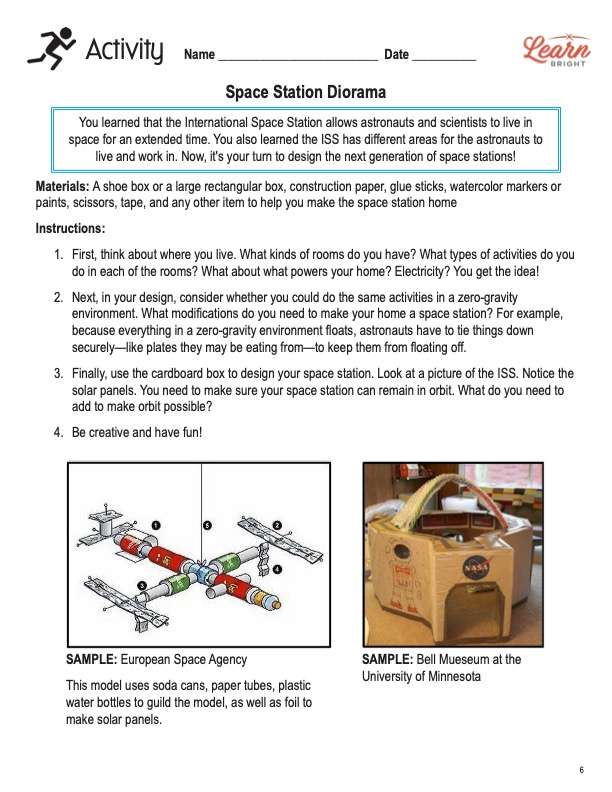Description
What our International Space Station lesson plan includes
Lesson Objectives and Overview: International Space Station is a high-interest reading comprehension lesson plan. As such, students will practice various close reading and comprehension skills. In addition, they will learn about the ISS and how/why it is the gateway to space exploration. This lesson is for students in 3rd grade, 4th grade, and 5th grade.
Classroom Procedure
Every lesson plan provides you with a classroom procedure page that outlines a step-by-step guide to follow. You do not have to follow the guide exactly. The guide helps you organize the lesson and details when to hand out worksheets. It also lists information in the yellow box that you might find useful. You will find the lesson objectives, state standards, and number of class sessions the lesson should take to complete in this area. In addition, it describes the supplies you will need as well as what and how you need to prepare beforehand. The materials you need for the activity include rectangular boxes, glue sticks, watercolor markers, construction paper, and other supplies.
Teacher Notes
The teacher notes page provides an extra paragraph of information to help guide the lesson and remind you what to focus on. It explains that you can teach this lesson in a whole-class setting or as an independent, small-group activity. The blank lines on this page are available for you to write out thoughts and ideas you have as you prepare the lesson.
INTERNATIONAL SPACE STATION LESSON PLAN CONTENT PAGES
Intro to the ISS
The International Space Station lesson plan contains three content pages. Students will first learn that the International Space Station (ISS) is one of the most incredible and technologically advanced labs in the world. It continues its mission to foster cooperation between international governments and scientific discovery. The mission or purpose of the ISS is “to enable long-term exploration of space and provide benefits to people on Earth.”
Launched in 1998, the station was built like a Lego model, with each piece added over time. It took more than 115 flights to construct the ISS. Even today, reconfiguring, remodeling, and retooling continue to keep the ISS in orbit. Fifteen countries operate there and have scientists visiting the ISS. More than 240 astronauts representing nineteen countries have made the ISS home for a period of time. The result is that over 3,600 researchers from 106 countries have completed more than 2,500 experiments, collaborating or working together with the astronauts living on the space station. The ISS is a model for international cooperation or diplomacy.
How big is the ISS? It’s big! The ISS is larger than an American football field. And its mass, or how much matter is in an object, is nearly one million tons. That is about the same weight as 400 economy cars on Earth! The ISS is big and heavy, so it must be slow, right? It might surprise you that even though the ISS is big, it’s actually fast. In fact, it’s about 17,500 miles per hour fast. The fastest jet in the world set a record by traveling 4,520 miles per hour, only one-fourth of the speed of the ISS. It takes the ISS roughly ninety minutes to orbit the earth. Can you see the ISS from Earth if it’s traveling that fast?
Despite this very quick speed, you can see the ISS from Earth! Flying about 400 kilometers or around 250 miles above the earth, the ISS looks like a small white dot moving across the sky. You can differentiate it from aircraft as it never changes direction and doesn’t have flashing lights. On a clear dark night, the ISS is even brighter than the moon.
What to Do on the International Space Station
How many people are on the ISS at the same time? The station is designed for a crew of six astronauts to live aboard. Generally, the missions last an average of six months before a new crew replaces the older one. However, one astronaut, Mark Vande Hei, set a new record in 2021 for time spent on the space station. He was in space for 355 days!
What do the astronauts and scientists do while on the ISS? Their main job is to conduct experiments. Because there is no gravity in space, the space station offers a unique opportunity to conduct experiments in a weightless environment. Some of these experiments have resulted in groundbreaking and exciting new discoveries in biology, medicine, physics, and environmental sciences. For example, investigations that collect data on weather patterns as seen from space benefit the research studying climate change.
Other experiments involve studying the physical changes in humans while in space. Because of the lack of gravity in space, humans who spend much time there experience muscle atrophy or become weaker. Scientists who want to send humans in space vehicles on more extended missions need to understand how to keep humans healthy in the future. More exciting is that space research is helpful for applications on our home planet.
It sounds like being on the space station is a lot of work! It is, but don’t let them fool you. There is time for relaxing and playing games. When there is downtime, the astronauts do many of the activities we do on Earth. For example, they have to get two hours of exercise daily. There is a gym on board. Over fifty computers are on board to play games, watch videos, read, or get on the internet. And, of course, there is breakfast, lunch, and dinner!
Living on the ISS
Students will then learn what it’s like to live in zero-gravity. Since the earliest days of space, eating in a zero-gravity environment has been challenging. Astronauts can’t just sit in a chair at a table and have a regular meal on plates. They float. So most of their meals are specially prepared or in special packaging.
Zero-gravity creates other challenges, as you might imagine. Tasks we take for granted on Earth are complex in space. Getting a haircut requires a unique tool that simultaneously cuts the hair and vacuums it. Using a toilet can be an adventure. The astronauts must be strapped in, or they might float off at the worst possible moment. Doing laundry is not a problem, though. Clothing is burned and replaced with new clothing delivered by unmanned shuttles. And new crews arrive with clothing for their stay. Speaking of burning, garbage is expelled from the craft and burns up on re- entry into the earth’s atmosphere.
Astronauts sleep in tiny rooms. They have to wear a sleeping mask when they sleep. Due to the speed the ISS travels, there are 16 sunrises and sunsets in the 24 hours the astronauts orbit Earth. The masks keep the room dark so they can sleep. While zero-gravity and space travel has presented unique challenges, the International Space Station has been able to adapt to them, making living in space a comfortable experience.
What is the future of the International Space Station? Unfortunately, and though it has served the world well, the ISS will be decommissioned (it will no longer be in use) sometime before 2028. The reason is that several countries have decided to build their own space stations. Sometime after 2028, the ISS will be recycled, allowed to burn up in the earth’s atmosphere, or sold to a private company. In the future, private companies will design space stations to conduct research and create space hotels. Regardless, the station has served the world as a space version of the United Nations. Its success demonstrates that world communities can unite behind everyday purposes and goals.
INTERNATIONAL SPACE STATION LESSON PLAN WORKSHEETS
The International Space Station lesson plan includes two worksheets: an activity worksheet and a practice worksheet. Each one will help students solidify their grasp of the material they learned throughout the lesson. You can refer to the classroom procedure guidelines to know when to hand out each worksheet.
SPACE STATION DIORAMA ACTIVITY WORKSHEET
For the activity, students will build a diorama of a space station using the materials you provide. There are pictures at the bottom of the page for ideas on how to build their models. Students should follow the instructions on the page but be creative in their designs.
INTERNATIONAL SPACE STATION PRACTICE WORKSHEET
The practice worksheet lists 11 questions based on the content. You can decide whether or not you allow students to use the content pages or review them prior to the assignment. You could also use this worksheet as a quiz to test their comprehension and retention.
Worksheet Answer Keys
At the end of the lesson plan document is an answer key for the practice worksheet. The correct answers are all in red to make it easier for you to compare them with students’ responses. If you choose to administer the lesson pages to your students via PDF, you will need to save a new file that omits these pages. Otherwise, you can simply print out the applicable pages and keep these as reference for yourself when grading assignments.









